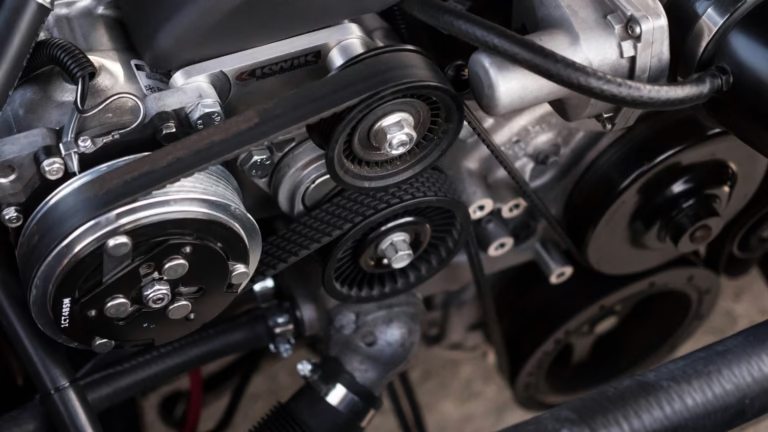
Replacing spark plugs is one of the most effective ways to maintain your Chevrolet Silverado’s performance, fuel efficiency, and engine health. Over time, worn-out spark plugs can lead to rough idling, misfires, and poor gas mileage. In this guide, we’ll walk you through the entire spark plug replacement process for the Chevy Silverado.
Tools & Materials Needed:
- New spark plugs (OEM-recommended for your model/year)
- Ratchet wrench
- Spark plug socket (usually 5/8” or 9/16”)
- Torque wrench
- Spark plug gap gauge
- Anti-seize compound (optional)
- Dielectric grease (optional)
- Extension bar
- Compressed air or a soft brush
- Gloves and safety glasses
Step 1: Prepare Your Work Area
Park your Silverado on a level surface. Let the engine cool completely if it’s been running, as working with a hot engine can be dangerous and damage internal components.
Disconnect the negative battery terminal to avoid electrical shorts while working on the ignition system.
Step 2: Locate the Spark Plugs
On most Silverado models, the spark plugs are found beneath the ignition coils on the side of the engine block. The Silverado typically comes with a V8 engine, which means there are 8 spark plugs—4 on each side.
Step 3: Remove Engine Covers
If your Silverado has plastic engine covers blocking access to the coils, remove them using a ratchet. Set the bolts aside and lift off the cover.
Step 4: Disconnect the Ignition Coils
Start with one coil at a time. Locate the electrical connector on the coil pack and carefully unplug it.
Using a socket and extension bar, unscrew the bolt holding the coil in place. Gently twist and pull the coil upward to remove it. You should now see the spark plug below.
Step 5: Clean the Area
Before removing the old spark plug, use compressed air or a soft brush to clean debris from around the plug well. This prevents dirt from falling into the combustion chamber once the plug is removed.
Step 6: Remove the Old Spark Plug
Insert the spark plug socket with an extension and carefully unscrew the old spark plug counterclockwise. Be cautious—too much force or a crooked angle can damage the threads inside the cylinder head.
Inspect the old spark plug for wear, oil, or carbon buildup. These signs may point to deeper engine issues.
Step 7: Check and Gap the New Spark Plug
Before installing a new spark plug, use a gap gauge to ensure the electrode gap matches the specifications in your Silverado owner’s manual. Pre-gapped plugs are common but not always accurate.
Apply a small dab of anti-seize compound to the threads if recommended. Also, apply dielectric grease to the inside of the ignition coil boot for better electrical conductivity and protection against moisture.
Step 8: Install the New Spark Plug
Carefully insert the new spark plug into the cylinder head and hand-tighten it to avoid cross-threading. Then use a torque wrench to tighten the spark plug to the manufacturer’s torque setting (typically between 18–25 lb-ft depending on the model/year).
Step 9: Reinstall the Ignition Coil
Place the ignition coil back over the spark plug, align it properly, and push it down firmly. Reinstall the coil bolt and plug the electrical connector back in.
Repeat the removal and installation process for the remaining spark plugs, one at a time.
Step 10: Final Check and Start the Engine
Once all spark plugs are replaced, reinstall any engine covers you removed earlier. Reconnect the negative battery terminal.
Start the engine and let it idle for a few minutes. Listen for any rough idling or misfires. If everything sounds normal, you’ve successfully replaced the spark plugs.
When to Replace Spark Plugs on a Chevy Silverado
Most Silverado models require spark plug replacement every 60,000 to 100,000 miles, depending on engine type and driving conditions. Refer to your owner’s manual for the exact service interval.
Signs You Need New Spark Plugs:
- Engine misfires
- Rough idling
- Slow acceleration
- Decreased fuel economy
- Check engine light (with misfire-related codes)
Why Spark Plug Maintenance Matters
Spark plugs are responsible for igniting the air-fuel mixture inside your engine. If they fail, it can lead to incomplete combustion, engine damage, and increased emissions. Replacing them on time:
- Improves throttle response
- Increases engine longevity
- Reduces fuel consumption
- Helps maintain smooth operation
Common Mistakes to Avoid
- Over-tightening the spark plugs (can strip threads)
- Cross-threading during installation
- Mixing up coil pack wires
- Skipping spark plug gap check
- Reusing old spark plugs without inspection




